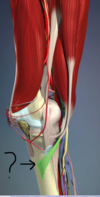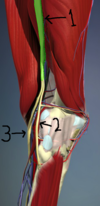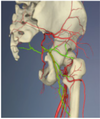Gluteal Region and Posterior Thigh Picture Cards Flashcards

- Body of ilium
- ASIS
- AIIS
- Pubic tubercle
- Body of pubis
- Inferior ramus of pubis
- Ramus of ischium
- Ischial tuberosity
- Body of ischium
- Rim of acetabulum
- Greater sciatic notch
Name the muscle, compartment, nerve supply, origin, insertion, and function.

Gracillis. Adductor compartment of the thigh. Innervated by the anterior division of the obturator nerve. Originates from from the anterior surface of the body of the pubis and inserts on the superomedial tibial shaft. Gracilis flexes the knee joint, medially rotates the leg when the knee is flexed and is a weak adductor of the thigh.
Name the muscle, compartment, nerve supply, and function.

Adductor magnus. Adductor compartment. Dual nerve supply from the posterior branch of the obturator nerve and the tibial component of the sciatic nerve. It adducts, extends and medially rotates the hip joint.
Name the muscle, compartment, nerve supply, origin, insertion, and function.

Semimembranosus. Posterior (hamstring) compartment of the thigh. Nerve supply is the tibial component of the sciatic nerve. Originates at the superolateral aspect of the ischial tuberostiy and inserts in the posteromedial corner of the medial tibial condyle. Flexes the knee and extends the hip.
Name the muscle, compartment, nerve supply, origin, insertion, and action.

Semitendinosus. Posterior (hamstring) component of the thigh. Innervated by tibial component of the sciatic nerve. Originates from the superomedial ischial tuberosity, inserts at the superomedial tibial shaft. It flexes the knee, extends the hip, and can also medially rotate the leg.
Name the muscle, compartment, nerve supply, origin, insertion, and action.

Biceps femoris - long head. Innervated by the tibial division of the sciatic nerve (note that the biceps short head is innervated by the peroneal division). Originates at the superomedial ischial tuberosity via the conjoined tendon with the semitendinosus and inserts distally on to the lateral fibular head. Action is to flex the knee and extend the hip, and it can also laterally rotate the leg.
Name these three muscles and their respective innervation.

- Gluteus maximus - innervated by the inferior gluteal nerve.
- Gluteus medius - innervated by superior gluteal nerve.
- Gluteus minimus - innervated by superior gluteal nerve.

- Gluteus minimus
- Obterator internus
- Gluteus medius
- Gluteus maximus
- Greater trochanter

Iliotibial tract
What is this? What side of the knee is this and how do you know? What muscles combine to attach here?

Pes anserinus. Medial side of the knee cuz the fibula is on the other side. The sartorius, gracilis and semitendinosus combine to attach here.
Name the muscle, compartment, nerve supply, origin, insertion, and action.

Biceps femoris - short head. Posterior (hamstring) compartment of the thigh. Innervated by the peroneal (common) segment of the sciatic nerve. Originates on the lateral linea aspera and inserts on the lateral fibular head. Acts with other hamstring muscles to flex the knee, extend the hip, and also some lateral rotation of the leg when the knee is semi flexed.

- Sciatic nerve
- Peroneal aka common fibular branch (lateral)
- Tibial branch (medial)

- Sacrotuberous ligament (running from Sacrum to ischial tuberosity).
- Sacrospinous ligament (running from Sacrum to ischial spine).
Name the muscles and their innervation.

- Obturator internus - nerve to obturator internus (L5, S1, S2)
- Quadratus femoris - nerve to quadratus femoris (L5, S1)
Name them + innervations.

- Superior gemellus - nerve to obturator internus (L5, S1, S2)
- Inferior gemellus - nerve to quadratus femoris (L5, S1)











